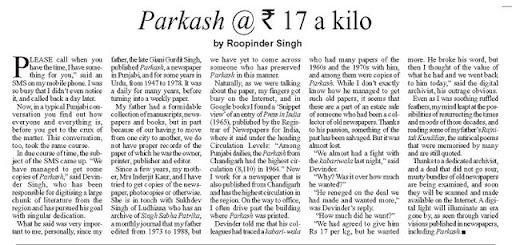“Please call when you have the time, I have something for you,” said an SMS on my mobile phone. I was so busy that I didn’t even notice it, and called back a day later.
Now, in a typical Punjabi conversation you find out how everyone and everything is before you get to the crux of the matter. This conversation, too, took the same course.
In due course of time, the subject of the SMS came up. “We have managed to get some copies of Parkash,” said Devinder Singh, who has been responsible for digitising a large chunk of literature from the region and has pursued his goal with singular dedication.
The Nanakshahi Trust, of which is has been an energetic part, has been on this mission since 2001, the year Wikipedia was born, and it and has ratcheted up significant success in this endeavour.
What he said was very important to me, personally, since my father, the late Giani Gurdit Singh, published Parkash, a newspaper in Punjabi, and for some years in Urdu, from 1947-1978. It was a daily for many years, before turning into a weekly paper.
My father had a formidable collection of manuscripts, newspapers and books, but in part because of our having to move from one city to another, we do not have proper records of the paper of which he was the owner, printer, publisher and editor.
Since a few years, my mother, Mrs Inderjit Kaur, and I have tried to get copies of the newspaper, photocopies or otherwise. She is in touch with Sukhdev Singh of Ludhiana who has an archive of Singh Sabha Patrika, a monthly journal that my father edited from 1973 to 1988, but we have yet to come across someone who has preserved Parkash in this manner.
Naturally, as we were talking about the paper, my fingers got busy on the Internet, and in Google books I found a ‘Snippet view’ of an entry of Press in India (1965), published by the Registrar of Newspapers for India. Under the heading Circulation Levels, it said: “Among Punjabi dailies, the Parkash from Chandigarh had the highest circulation (8,110) in 1964.”
Now I work for a newspaper that is also published from Chandigarh and has the highest circulation in the region. On the way to office, I often drive past the building where Parkash was printed.
Devinder told me that his colleagues had traced a kabari- wala who had many papers of the 1960s and the 1970s with him, and among them were copies of Parkash.
While I don’t exactly know how he managed to get such old papers, it seems that these are a part of an estate sale of someone who had been a collector of old newspapers. Thanks to his passion, something of the past has been salvaged. But it was almost lost.
“We almost had a fight with the kabari wala last night,” said Devinder.
“Why? Was it over how much he wanted?”
“He reneged on the deal we had made and wanted more,” was Devinder’s reply.
“How much did he want?”
“We had agreed to give him Rs 17 per kg, but he wanted more. He broke his word, but then I thought of the value of what he had and we went back to him today,” said the digital archivist, his outrage obvious.
Even as I was soothing ruffled feathers, my mind leapt at the possibilities of resurrecting the times and moods of those decades, and reading some of my father’s Rajnitak Kundilias, the satirical poems that were memorised by many and are still quoted.
Thanks to a dedicated archivist, and a deal that did not go sour. Musty bundles of old newspapers are being examined, and soon they will be scanned and made available on the Internet. A digital light will illuminate an era gone by, as seen through varied visions published in newspapers, including Parkash.

The middle was published in published in The Tribune on January 24
